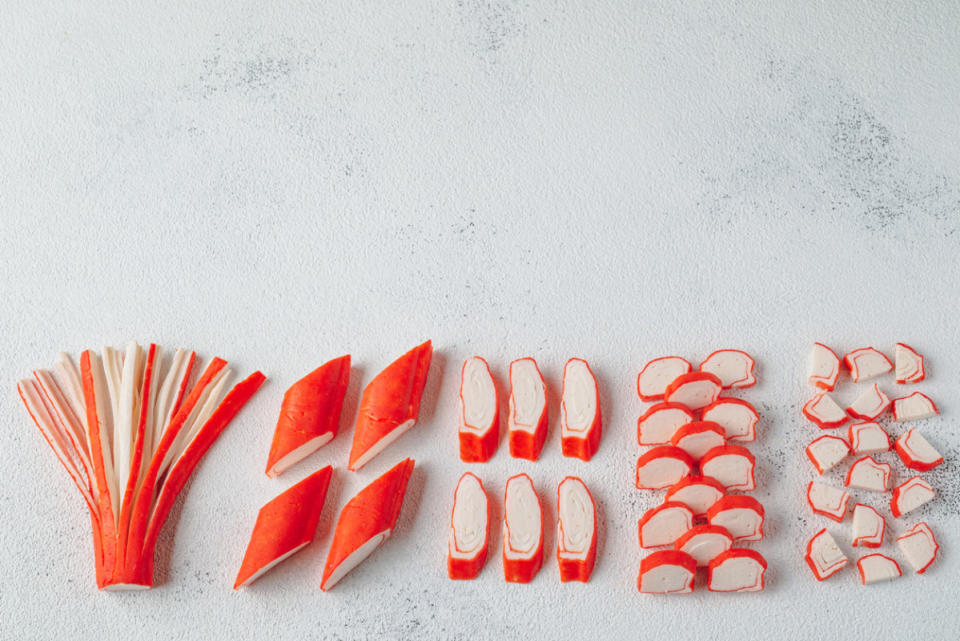What's the Deal With Imitation Crab?

Sliced imitation crab
There's a pretty good chance that you've had imitation crab (aka "crab with a k") in a California roll or crab dip, but there's also a pretty good chance you don't know exactly how the crabby carbon copy came to be, how it's made and what else you can do with it. Luckily for you, we have all of that info (and more). We quizzed Jade Silverstein, Sustainable Seafood Consultant and Sales Associate at Cold Spring Fish to discover the true tale behind imitation crab.
Related: The 8 Most Common Kinds of Sushi
What is imitation crab?
"Imitation crab is made of white fish, starch and other ingredients to create the texture and taste of crab meat," explains Silverstein. "The preparation of fish for imitation crab is actually a Japanese method called surimi, which is used not just for imitation crab but also to make fish sticks, fish cakes and other popular seafood dishes."
According to a 2007 article from Oregon State, Japanese chefs have been making surimi for hundreds of years by mixing leftover fish filets with salt to create a type of "fish gel" to preserve the extra catch. In the 1960s, a Japanese chemist realized that adding sugar to surimi could allow it to be stabilized and frozen, launching the international surimi industry and wider use of the ingredient. To make imitation crab, surimi is mixed with other ingredients, then heated and pressed into crab-like shapes.
Related: 100 of Our Best Seafood Recipes

iStock
Does imitation crab taste like real crab meat?
"Yes," says Silverstein. "Imitation crab tastes like crab and is a good substitute for crab meat. It is especially a tasty and healthy option for kids who may not like the taste of crab meat."
"The common perception of imitation crab is that it is an artificial product because of the term 'imitation,'" says Silverstein, but it is important to remember it is made with fish. "The fish used in imitation crab are white fish such as pollock, cod or haddock, which are some of the most commonly consumed fish on the market."
She also adds that the starch in imitation crab is made with wheat, but each brand has a different mix of ingredients for their product, with some using actual crab meat and flavoring, which is why it's best to avoid imitation crab if you have any crab allergies.
Related: Chrissy Teigen's Spicy Crab Dip
How can you tell the difference between real and imitation crab?
"Imitation crab looks and cooks just like crab meat, but its texture is slightly different, often smoother and denser than actual crab meat," says Silverstein. While the word "imitation" or "Krab" is often used in the U.S., Silverstein says advertising laws in some countries do not allow the term "imitation crab." "You may see 'fish sticks' or 'fish cakes' on the packaging of products intended to be used as imitation crab," she says.
Although different brands of imitation crab have different ingredients, according to Healthline, surimi makes up about 35-50% of "imitation crab" while the rest of the ingredients often include water, starch, protein, sugar and sorbitol, vegetable oil and salt. Before you buy imitation crab, be sure to check the ingredients label.
The other big difference between imitation crab and real crab is the price. Imitation crab often is about 1/3 the price of the real deal.
Related: Grandma's Crab Cake Sandwich
What dishes is imitation crab good for?
"Imitation crab meat is most often used for sushi, mainly California rolls, which is a favorite for kids because of its mild and sweet taste, and that it is fully cooked," explains Silverstein.
"At our shop, we use imitation crab meat for sushi rolls and for nicoise-style salads, and real crab meat for our locally famous crab cakes," says Silverstein. She loves making an imitation crab salad by mixing chopped imitation crab with mayo, mustard, onions, celery, scallions, red pepper, lemon juice and parsley. She serves the salad in an avocado half over a green salad for a light lunch or a summertime supper.
Affordable, accessible imitation crab is a good choice in dishes where crab is an ingredient, rather than the main draw (like crab legs with drawn butter). Try it in crab rangoon, crab pasta salad, crab dip or for a mayo-based salad that tastes kind of like a lobster roll.
Related: 65 Great Simple Salmon Suppers
Is there another type of fish you can use as a crab substitute if you don’t want to use imitation crab?
"Pollock is the most commonly used fish in imitation crab, so similar-tasting whitefish such as cod, haddock, halibut and flounder are great alternatives, but they will not taste like crab meat unless prepared as surimi," says Silverstein.
Related: 55 Best Air Fryer Fish Recipes
Is imitation crab healthy?
It depends on who you ask. Because it's a processed food, some steer clear of imitation crab. It also has less protein and more sugar than real crab, though the nutritional information varies by brand.
But Silverstein thinks about imitation crab a little differently, along with many people around the world. "Imitation crab is an affordable option and a great way to add healthy fish to your diet," says Silverstein. "Imitation crab can also be a sustainable option—the health of wild fisheries is ever-changing, with many being severely impacted by climate change," she says. "Imitation crab meat made with sustainably managed fish such as pollock and cod can be a sustainable alternative to crab meat."
Up next: 25 Great Low-Carb Seafood Recipes

